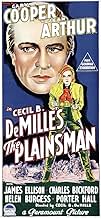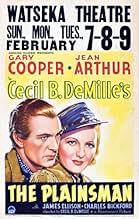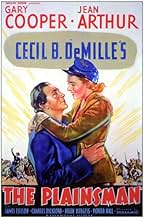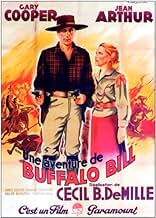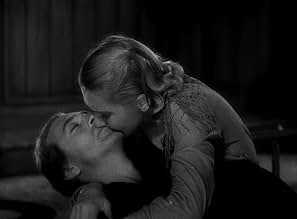NOTE IMDb
6,8/10
2,5 k
MA NOTE
Ajouter une intrigue dans votre langueWild Bill Hickok and Buffalo Bill Cody attempt to stop an Indian uprising that was started by white gun-runners.Wild Bill Hickok and Buffalo Bill Cody attempt to stop an Indian uprising that was started by white gun-runners.Wild Bill Hickok and Buffalo Bill Cody attempt to stop an Indian uprising that was started by white gun-runners.
- Réalisation
- Scénario
- Casting principal
- Récompenses
- 3 victoires au total
Fred Kohler
- Jake - A Teamster
- (as Fred Kohler Sr.)
Pat Moriarity
- Sgt. McGinnis
- (as Pat Moriarty)
Avis à la une
This movie has Wild Bill Hickok, Calamity Jane, Buffalo Bill and General Custer all together. Gary Cooper plays Wild Bill and Jean Arthur plays Calamity Jane and Charles Bickford plays the bad guy who sells weapons to the Indians and you can hardly recognize him. This was the first time Cecil B. DeMille and Gary Cooper worked together and the next movie the made was basically the same but set in a different time. This movie starts out with Lincoln's assassination and it also deals with an Indian war. Calamity Jane is in love with Wild Bill and Buffalo Bill has gotten married and now wants to stay home. This movie also deals with Custer's last stand and is far from accurate. Gary Cooper is good as usual and i usually don't like Jean Arthur but i liked her here.
Wild Bill Hickock, Buffalo Bill Cody, and Calamity Jane fight alongside General Custer and expose a scheme by greedy arms manufacturers to sell repeating rifles to renegade Indians.
This somewhat gratuitous exercise in wild west name-dropping is pretty silly but also fairly entertaining as well, though it's a bit too long and runs out of steam near the end.
Also, it might be off-putting to many modern viewers due to it's politically incorrect, stereotyped treatment of Indians.
The feisty Jean Arthur is extremely cute as Calamity Jane and easily runs away with the picture.
Recognizable cameos include iconic western sidekick George "Gabby" Hayes as a wounded scout and director Cecile B. DeMille's future son-in-law Anthony Quinn as the Cheyenne brave who relates the news of Custer's last stand to Cody and Hickock.
This somewhat gratuitous exercise in wild west name-dropping is pretty silly but also fairly entertaining as well, though it's a bit too long and runs out of steam near the end.
Also, it might be off-putting to many modern viewers due to it's politically incorrect, stereotyped treatment of Indians.
The feisty Jean Arthur is extremely cute as Calamity Jane and easily runs away with the picture.
Recognizable cameos include iconic western sidekick George "Gabby" Hayes as a wounded scout and director Cecile B. DeMille's future son-in-law Anthony Quinn as the Cheyenne brave who relates the news of Custer's last stand to Cody and Hickock.
There were not a lot of Westerns in the 1930s, at least not in the A-budget bracket. So why would that canny marketeer and bandwagon-hopper Cecil B. DeMille decide to make one in 1936? The answer is simple. After the failure of his few dramas in the early talkie period, he vowed to make only "big" pictures, and the Old West was simply another historical arena for grand heroic exploits, just like the crusades or the high seas.
This being DeMille, the idea seems to have been to do a kind of definitive take on the setting. Waldemar Young and Harold Lamb, DeMille's current hacks-du-jour, along with "Oklahoma" playwright Lynn Riggs have created a screenplay that is not so much a cliché-fest as a cosy, sanitised and highly anachronistic snapshot of Western mythology. So we get Wild Bill Hickok, Calamity Jane, Buffalo Bill and General Custer all cheerfully rubbing shoulders like an Old West version of The League of Extraordinary Gentlemen, and banding together against the common enemy (the injuns, of course). DeMille's penchant for historical accuracy may give the sets and costumes a look of authenticity, but does not extend as far as actually portraying Calamity as a drunken prostitute, and Hickok as a kind of 19th-century Lemmy from Motorhead.
The two leads may not look like their historical counterparts, but at least Gary Cooper and Jean Arthur have the rugged demeanour of frontierspeople. They are also good enough performers to do a decent job despite a lack of coaching from DeMille. But as is often the case, the most interesting players are the villains. Charles Bickford looks as if he was chiselled from the buttes of the plains themselves, and gives a performance comparable to Walter Huston's Trampas in the 1929 version of The Virginian. Victor Varconi, once a handsome lead man in the silents, now thanks to his accent and looks reduced to playing all manner of swarthy baddies, is compellingly menacing as Painted Horse. And finally a young Anthony Quinn makes a short but impressive appearance as a Cheyenne warrior, lending a degree of dignity to the natives that is woefully absent in the rest of the picture.
DeMille himself though does not appear to have "got" the genre. Despite the title, we don't really get to see those plains, and there is none of the romance of the outdoor lifestyle that makes classic Westerns what they are. But looking at DeMille's style you can see he is not a fan of empty spaces. Bigness for him means fullness. He really goes to town on the steamboat boarding scene, conjuring up an image of lively bustle with people moving across the frame in layers receding in depth. This is a very effective way of making a place look crowded without having to place the camera too far back or hire out every extra on the books. In other scenes, such as the one where the townspeople threaten to tar and feather Jean Arthur he uses extras to build walls around the action, filling every spare space with people. Even in simpler scenes there tends to be a degree of complexity to the shot, like a classical painting that tries to cram every aspect of an idea onto the canvas. And DeMille's images are often beautiful in a painterly way, but still the lack of "west" on display stops this from feeling like a Western.
Think of this then more as an adventure yarn than a horse opera. It may be silly as silly can be (my favourite daft moment is in the opening scene, when Abe Lincoln's wife bursts into a meeting to remind him he's going to be late for the theatre, followed by a doom-laden chord in the background score), but it is not bad as far as no-brainer entertainment goes. The action scenes are exciting and punchy, largely thanks to the dynamic editing of Anne Bauchens. This is by no means essential DeMille, and certainly not essential Cooper, but is good fun if you happen to catch it.
This being DeMille, the idea seems to have been to do a kind of definitive take on the setting. Waldemar Young and Harold Lamb, DeMille's current hacks-du-jour, along with "Oklahoma" playwright Lynn Riggs have created a screenplay that is not so much a cliché-fest as a cosy, sanitised and highly anachronistic snapshot of Western mythology. So we get Wild Bill Hickok, Calamity Jane, Buffalo Bill and General Custer all cheerfully rubbing shoulders like an Old West version of The League of Extraordinary Gentlemen, and banding together against the common enemy (the injuns, of course). DeMille's penchant for historical accuracy may give the sets and costumes a look of authenticity, but does not extend as far as actually portraying Calamity as a drunken prostitute, and Hickok as a kind of 19th-century Lemmy from Motorhead.
The two leads may not look like their historical counterparts, but at least Gary Cooper and Jean Arthur have the rugged demeanour of frontierspeople. They are also good enough performers to do a decent job despite a lack of coaching from DeMille. But as is often the case, the most interesting players are the villains. Charles Bickford looks as if he was chiselled from the buttes of the plains themselves, and gives a performance comparable to Walter Huston's Trampas in the 1929 version of The Virginian. Victor Varconi, once a handsome lead man in the silents, now thanks to his accent and looks reduced to playing all manner of swarthy baddies, is compellingly menacing as Painted Horse. And finally a young Anthony Quinn makes a short but impressive appearance as a Cheyenne warrior, lending a degree of dignity to the natives that is woefully absent in the rest of the picture.
DeMille himself though does not appear to have "got" the genre. Despite the title, we don't really get to see those plains, and there is none of the romance of the outdoor lifestyle that makes classic Westerns what they are. But looking at DeMille's style you can see he is not a fan of empty spaces. Bigness for him means fullness. He really goes to town on the steamboat boarding scene, conjuring up an image of lively bustle with people moving across the frame in layers receding in depth. This is a very effective way of making a place look crowded without having to place the camera too far back or hire out every extra on the books. In other scenes, such as the one where the townspeople threaten to tar and feather Jean Arthur he uses extras to build walls around the action, filling every spare space with people. Even in simpler scenes there tends to be a degree of complexity to the shot, like a classical painting that tries to cram every aspect of an idea onto the canvas. And DeMille's images are often beautiful in a painterly way, but still the lack of "west" on display stops this from feeling like a Western.
Think of this then more as an adventure yarn than a horse opera. It may be silly as silly can be (my favourite daft moment is in the opening scene, when Abe Lincoln's wife bursts into a meeting to remind him he's going to be late for the theatre, followed by a doom-laden chord in the background score), but it is not bad as far as no-brainer entertainment goes. The action scenes are exciting and punchy, largely thanks to the dynamic editing of Anne Bauchens. This is by no means essential DeMille, and certainly not essential Cooper, but is good fun if you happen to catch it.
Conceived and executed with all the brio typical of a De Mille epic - all the 64 pistols used in the film came from his personal collection - 'The Plainsman', for all its attention to petty historical detail (De Mille was insistent that the Phrase 'Go West, Young man' be correctly attributed to John B. Searle, the Editor of The Terra Haute Express) plays fast and loose with history.
Cooper is the austere Hickok, Ellison (a regular in the Hopalong Cassidy series, loaned to De Mille by 'Pops' Sherman)a boyish Buffalo Bill, Arthur a breezy Calamity Jane and Miljan a heroic Custer to whose defence all three come. Bickford is the smooth gun running villain. De Mille's well-practised abilities in handling big budgets, big casts and big stories overcame the doggedly domestic drama of Cooper and Arthur's relationship. Slow moving and overly romantic by modern standards in its depiction of Westward expansion, 'The Plainsman' remains an entertaining spectacle.
In 1966, Universal remade the movie as a vastly inferior telefilm.
Phil Hardy
Cooper is the austere Hickok, Ellison (a regular in the Hopalong Cassidy series, loaned to De Mille by 'Pops' Sherman)a boyish Buffalo Bill, Arthur a breezy Calamity Jane and Miljan a heroic Custer to whose defence all three come. Bickford is the smooth gun running villain. De Mille's well-practised abilities in handling big budgets, big casts and big stories overcame the doggedly domestic drama of Cooper and Arthur's relationship. Slow moving and overly romantic by modern standards in its depiction of Westward expansion, 'The Plainsman' remains an entertaining spectacle.
In 1966, Universal remade the movie as a vastly inferior telefilm.
Phil Hardy
This Cecil B. DeMille movie has all the trademarks of that director. It's a big and spectacular look at the Old West. Perhaps there's a bit too much emphasis on creating an epic and not enough on telling a good story.
To be clear, I don't mind that it takes so many liberties with historical facts. When I watch a movie I don't necessarily need a history lesson, and I can forgive a movie taking liberties in order to tell a good story.
However, there is little subtlety and emotional weight in the storytelling. In the first half, things happen to move the story along, without necessarily making much sense.
Gary Cooper, not my favorite among the western genre's big stars, is aloof as Wild Bill Hickok. No one can deny his cinematic presence, though. Jean Arthur brings some fun to her role as Calamity Jane. I have seen some reviewers praising her performance, but the problem is, she never seems convincing. Lead actresses of this era were expected to be beautiful, romantic and sensitive, and that's fine when they play a beautiful, romantic and sensitive woman, which is most of the time. But Calamity Jane? Can we buy Jane Arthur as dissolute, unconventional and wild? The script gives her more to do in this movie than most actresses get in westerns of this period, but she still has to spend the movie mooning after a disdainful Gary Cooper to provide the conventional romance.
I feel like I'm being more negative than the movie deserves. It's just the it doesn't always live up to its ambition. Once you accept that you can't take the story too seriously, you can enjoy it as harmless entertainment. In fact, it finds more focus in the second half of the movie, which is quite fine.
To be clear, I don't mind that it takes so many liberties with historical facts. When I watch a movie I don't necessarily need a history lesson, and I can forgive a movie taking liberties in order to tell a good story.
However, there is little subtlety and emotional weight in the storytelling. In the first half, things happen to move the story along, without necessarily making much sense.
Gary Cooper, not my favorite among the western genre's big stars, is aloof as Wild Bill Hickok. No one can deny his cinematic presence, though. Jean Arthur brings some fun to her role as Calamity Jane. I have seen some reviewers praising her performance, but the problem is, she never seems convincing. Lead actresses of this era were expected to be beautiful, romantic and sensitive, and that's fine when they play a beautiful, romantic and sensitive woman, which is most of the time. But Calamity Jane? Can we buy Jane Arthur as dissolute, unconventional and wild? The script gives her more to do in this movie than most actresses get in westerns of this period, but she still has to spend the movie mooning after a disdainful Gary Cooper to provide the conventional romance.
I feel like I'm being more negative than the movie deserves. It's just the it doesn't always live up to its ambition. Once you accept that you can't take the story too seriously, you can enjoy it as harmless entertainment. In fact, it finds more focus in the second half of the movie, which is quite fine.
Le saviez-vous
- AnecdotesJohn Wayne very much wanted the role of Wild Bill Hickok, which he felt certain would make him a star, but director Cecil B. DeMille wanted Gary Cooper instead.
- GaffesOn the evening of Lincoln's assassination Van Ellyn and his associates are discussing the supposedly then current John Soule editorial, "Go West, Young Man." Lincoln was murdered in 1865. Soule wrote that famous line in 1851.
- Citations
Calamity Jane: Tip your hat when you speak to a lady!
Wild Bill Hickok: I will... when I speak to a lady.
- Versions alternativesThe UK DVD is cut by 2 secs to remove a horsefall.
- ConnexionsFeatured in The Hollywood Collection: Anthony Quinn an Original (1990)
- Bandes originalesWhen Johnny Comes Marching Home
(1863) (uncredited)
Written by Louis Lambert
Played as background music for the first scene, Washington, D.C.
Meilleurs choix
Connectez-vous pour évaluer et suivre la liste de favoris afin de recevoir des recommandations personnalisées
- How long is The Plainsman?Alimenté par Alexa
Détails
Box-office
- Budget
- 1 000 000 $US (estimé)
- Durée1 heure 53 minutes
- Couleur
- Rapport de forme
- 1.37 : 1
Contribuer à cette page
Suggérer une modification ou ajouter du contenu manquant

Lacune principale
What is the French language plot outline for Une aventure de Buffalo Bill (1936)?
Répondre



